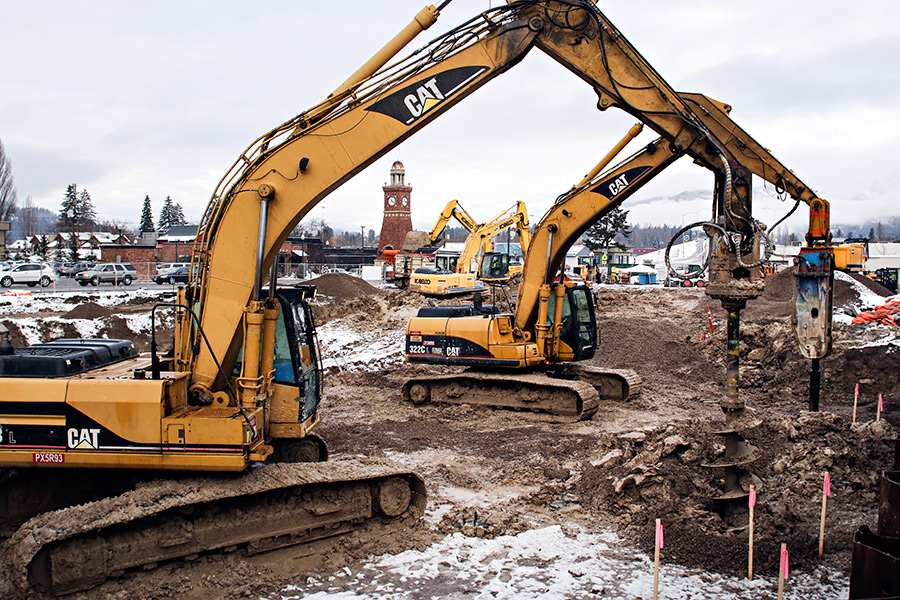Building City Hall Presents Challenge of Balancing Budget and Quality
Whitefish officials reviewing possible cutbacks or increased budget for new city hall and parking structure amid $1 million overrun
By Dillon Tabish
WHITEFISH — Tile covering the walls of public bathrooms from floor to ceiling for $12,000. Nope.
Canopies along the entire exterior of city hall along Baker Avenue for $53,000. Not this storefront.
Ornamental molding around the edge of the roof for $32,000. Just fine without it.
One by one, city officials and architects are combing through the lengthy list of line items for the new city hall and parking structure, agonizing over every detail in light of sudden cost overruns that are plaguing the multi-million dollar project.
Construction of the new three-story building and 212-space parking structure is still in the early stages but budgetary issues have already surfaced, forcing city council members and staff to wrestle with budget constraints and the integrity of the future facility.
At a Dec. 7 meeting, City Manager Chuck Stearns informed the city council of an estimated $1.7 million shortfall due to unexpected costs and the fluid design process.
A number of factors are leading to higher-than-expected costs, including increases for steel, concrete and labor, Stearns said.
A steering committee tasked with overseeing the project is recommending the city council consider multiple options to reduce roughly $772,000 by cutting back on budget items and allocating new funds to the design and construction by borrowing from the tax increment finance district and allocating leftover money from an ancillary fund.
The council voted Dec. 7 to keep a $90,000 elevator, which was identified as a possible cutback, but councilors were unable to fully review and vote on other items as the meeting approached midnight. If council follows the committee’s recommended cuts, the budget shortfall would be closer to $1 million.
The situation is also been made worse by a significant bookkeeping mistake. It was recently discovered that a line item for furniture was unintentionally omitted from the working budget, adding to the sudden funding shortage to the tune of $400,000.
“We have a bigger problem than we thought,” Stearns told councilors.
At a Dec. 11 meeting with members of the city hall steering committee, Stearns noted that the line item for furniture was in the city’s $14.95 million budget when the council approved it in June.
Much has changed since then as city staff has worked closely with architects and contractors to fine-tune the project as it moves forward over the next two years, but exactly how a major item totaling nearly half a million dollars disappeared remains unanswered.
Ben Tintinger, the project architect for Mosaic Architecture who spoke at the Dec. 11 meeting via conference call, was unable to explain how the line item was removed, saying there was “confusion in just whose budget” left out the furniture.
“At this point, we understand we thought it was under Chuck’s. Chuck thought it was under us. We all understand there was a lack of communication there on our part,” Tintinger said. “I apologize for that but we have to move forward.”
The discussion on Dec. 11 turned to the multiple spreadsheets detailing the budget and line items for the massive project and a possible way to streamline the process by creating one master document.
“We are advocating for everybody to be on one spreadsheet so we don’t miss any costs, one spreadsheet that has all the correct costs on it,” Steve Conway from Martel Construction, the project contractor, said via conference call.
Conway said he, too, was “totally flabbergasted” that the furniture item was omitted.
The cost overruns and confusion over multiple spreadsheets are a glaring demonstration of the complexities of building a major public facility, especially one as contentious and monumental as Whitefish’s downtown City Hall.
Whitefish has debated building a new city hall since the 1980s. The development picked up steam in recent years after the council identified it as a priority.
In late October, the 98-year-old city hall came down, making way for a new 21,000-square-foot facility with a parking structure and adjacent retail space in the heart of town. But as the building comes together, the city must look hard at how to fund any overages. If the council votes to increase the project’s budget, the funding would most likely come from the tax increment finance district, which has collected property tax revenues in the downtown for redevelopment projects and is supplying almost all of the money for the city hall project.
As other large local capital projects have shown — the renovated high school and middle school, the emergency services building — sticking to an exact budget is far from a perfect science.
“It’s to be expected to some degree,” Whitefish Mayor John Muhlfeld told the Beacon in regards to the cost overrun.
“We certainly didn’t anticipate being at this critical point where we’re needing to re-evaluate the budget and what components of the city hall and parking structure are going to be integral to functionality purposes of this building. I think with any large capital project, you reach this crossroads and that’s where we are.”
Muhlfeld said the goal moving forward would be to balance costs with the improvement of governmental services as well as economic development, which the mayor says is a key component of the new parking structure.
“We are making a substantial investment in the future of our downtown,” he said.
“The public needs to understand that the council is doing everything it can to bring this cost down and we’ll continue to operate transparently and make the decisions that are difficult but in the best interest of fiscal responsibility but also ensuring we don’t compromise the functionality and goal of this project, which was primarily economic development.”
The council will meet again to review the matter at its first meeting in January.